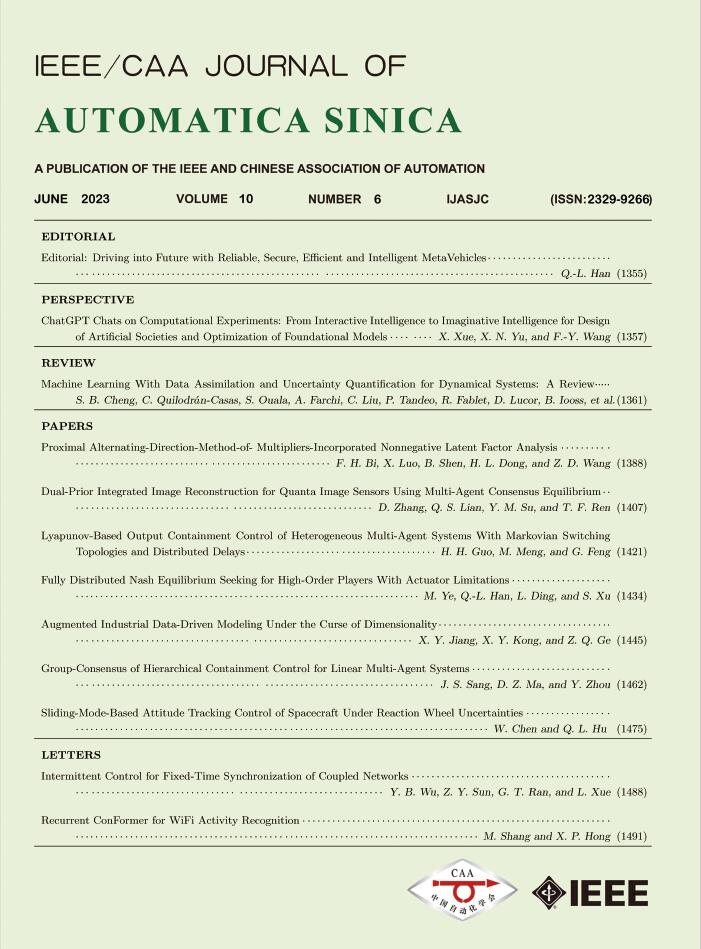 Volume 10
Issue 6
Volume 10
Issue 6
IEEE/CAA Journal of Automatica Sinica
| Citation: | Y. P. Xu, L. Liu, N. Gu, D. Wang, and Z. H. Peng, “Multi-ASV collision avoidance for point-to-point transitions based on heading-constrained control barrier functions with experiment,” IEEE/CAA J. Autom. Sinica, vol. 10, no. 6, pp. 1494–1497, Jun. 2023. doi: 10.1109/JAS.2022.105995 |

| [1] |
Z. Peng, J. Wang, D. Wang, and Q. Han, “An overview of recent advances in coordinated control of multiple autonomous surface vehicles,” IEEE Trans. Industrial Informatics, vol. 17, no. 2, pp. 732–745, Feb. 2021.
|
| [2] |
H. Wei, Q. Sun, J. Chen, and Y. Shi, “Robust distributed model predictive platooning control for heterogeneous autonomous surface vehicles,” Control Engineering Practice, vol. 107, p. 104655, Feb. 2021.
|
| [3] |
L. Zuo, W. Yan, R. Cui, and J. Gao, “A coverage algorithm for multiple autonomous surface vehicles in flowing environments,” Int. J. Control Automation &Systems, vol. 14, no. 2, pp. 540–548, Apr. 2016.
|
| [4] |
M. Akdağ, P. Solnor, and T. A. Johansen, “Collaborative collision avoidance for maritime autonomous surface ships: A review,” Ocean Engineering, vol. 250, p. 110920, Apr. 2022.
|
| [5] |
S. Dai, S. He, M. Wang, and C. Yuan, “Adaptive neural control of underactuated surface vessels with prescribed performance guarantees,” IEEE Trans. Neural Networks and Learning Systems, vol. 30, no. 12, pp. 3686–3698, Dec. 2019. doi: 10.1109/TNNLS.2018.2876685
|
| [6] |
H. Lyu and Y. Yin, “COLREGS-constrained real-time path planning for autonomous ships using modified artificial potential fields,” J. Navigation, vol. 72, no. 3, pp. 588–608, Nov. 2018.
|
| [7] |
R. Zhang, P. Tang, Y. Su, X. Li, G. Yang, and C. Shi, “An adaptive obstacle avoidance algorithm for unmanned surface vehicle in complicated marine environments,” IEEE/CAA J. Autom. Sinica, vol. 1, no. 4, pp. 385–396, Oct. 2014. doi: 10.1109/JAS.2014.7004666
|
| [8] |
X. Ge, Q.-L. Han, J. Wang, and X.-M. Zhang, “A scalable adaptive approach to multi-vehicle formation control with obstacle avoidance,” IEEE/CAA J. Autom. Sinica, vol. 9, no. 6, pp. 990–1004, Jun. 2022. doi: 10.1109/JAS.2021.1004263
|
| [9] |
J. Yan, X. Li, X. Yang, X. Luo, C. Hua, and X. Guan, “Integrated localization and tracking for AUV with model uncertainties via scalable sampling-based reinforcement learning approach,” IEEE Trans. Systems,Man,and Cybernetics: Systems, vol. 52, no. 11, pp. 6952–6967, 2022. doi: 10.1109/TSMC.2021.3129534
|
| [10] |
T. Xu, S. Zhang, Z. Jiang, Z. Liu, and H. Cheng, “Collision avoidance of high-speed obstacles for mobile robots via maximum-speed aware velocity obstacle method,” IEEE Access, vol. 8, pp. 138493–138507, Jul. 2020. doi: 10.1109/ACCESS.2020.3012513
|
| [11] |
Z. Sui, Z. Pu, J. Yi, and S. Wu, “Formation control with collision avoidance through deep reinforcement learning using model-guided demonstration,” IEEE Trans. Neural Networks and Learning Systems, vol. 32, no. 6, pp. 2358–2372, Jun. 2021. doi: 10.1109/TNNLS.2020.3004893
|
| [12] |
H. Wang, J. Peng, F. Zhang, H. Zhang, and Y. Wang, “High-order control barrier functions-based impedance control of a robotic manipulator with time-varying output constraints,” ISA Transactions, vol. 129, pp. 361–369, 2022. doi: 10.1016/j.isatra.2022.02.013
|